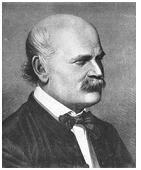Ignaz Semmelweisis regarded as the father of infection control because of his discovery of the cause of maternal death during childbirth. Ignaz introduced an infection control method known as antisepsis to control the contamination of the labour room by pathogenic microorganisms which caused the death of pregnant women during childbirth as at the time. Ignaz was a Hungarian physician, and he showed that child-bed fever was spread by physicians and could be prevented by careful washing of the hands.
He realized that blood poisoning agents were transmitted to maternity patients by physicians fresh from performing autopsies in the mortuary, and he also observed that asepsis in obstetrical wards could prevent the transmission of childbirth fever from patient to patient. Ignaz Semmelweis therefore instigated a policy that all attending physicians must wash their hands with chloride of lime, and between patients – as this procedure reduced the spread of disease.
Even though he is still remembered for his contributions towards the principle of disinfection (a practices that can stop the spread of disease or infection), his true call for disinfection practices in the medical profession was largely unheeded to as at the time because it implied that physicians were at fault in this case.
However, Ignaz’s discovery of aseptic technique or antisepsis in obstetric wards as at the time is still used till date as an important infection control practice in hospitals. And hand washing technique which is one of the most veritable tool in preventing microbial contamination of the hands and the entire body is still being practiced all over the world as the surest way of keeping microbes at bay.
The work of Ignaz Semmelweis showed that pathogenic microorganisms can be controlled on the human body and on other abiotic surfaces by using certain antimicrobial agents such as antiseptics and disinfectants to control microbial growth.
References
Barrett J.T (1998). Microbiology and Immunology Concepts. Philadelphia, PA: Lippincott-Raven Publishers. USA.
Beck R.W (2000). A chronology of microbiology in historical context. Washington, D.C.: ASM Press.
Brooks G.F., Butel J.S and Morse S.A (2004). Medical Microbiology, 23rd edition. McGraw Hill Publishers. USA. Pp. 248-260.
Chung K.T, Stevens Jr., S.E and Ferris D.H (1995). A chronology of events and pioneers of microbiology. SIM News, 45(1):3–13.
Slonczewski J.L, Foster J.W and Gillen K.M (2011). Microbiology: An Evolving Science. Second edition. W.W. Norton and Company, Inc, New York, USA.
Summers W.C (2000). History of microbiology. In Encyclopedia of microbiology, vol. 2, J. Lederberg, editor, 677–97. San Diego: Academic Press.
Talaro, Kathleen P (2005). Foundations in Microbiology. 5th edition. McGraw-Hill Companies Inc., New York, USA.
Discover more from #1 Microbiology Resource Hub
Subscribe to get the latest posts to your email.



